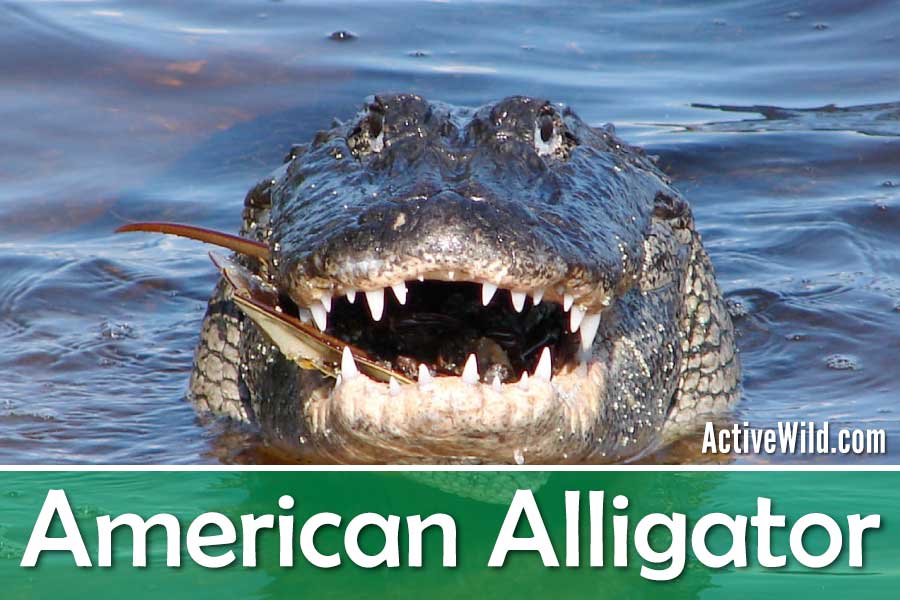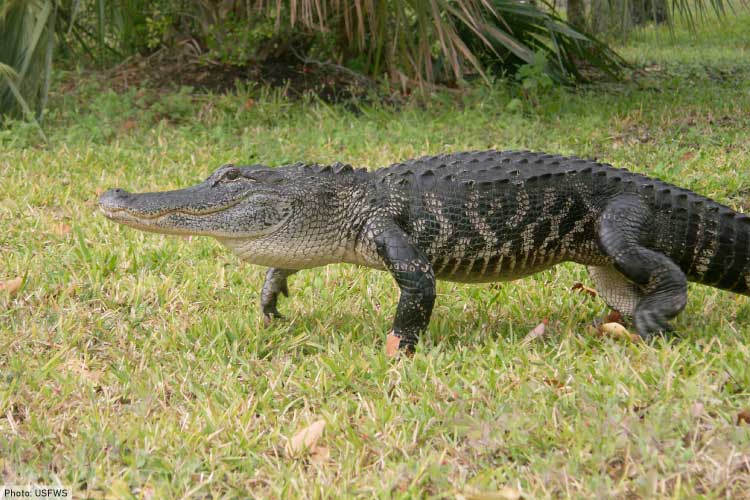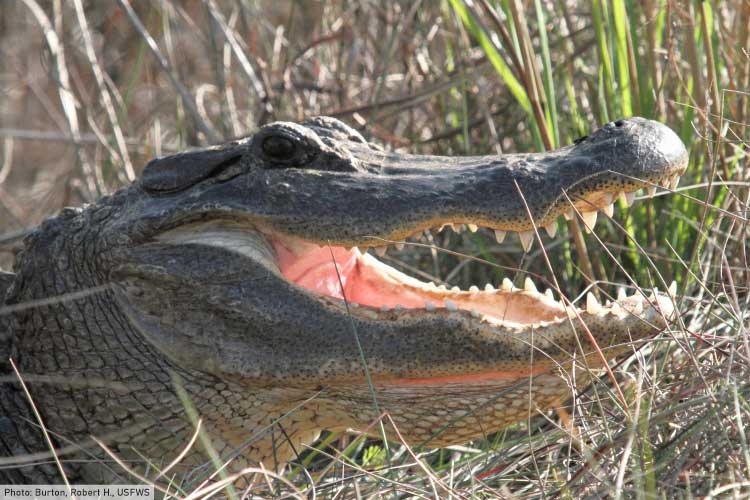The American alligator (Alligator mississippiensis) is large predatory reptile found across the southeastern United States from North Carolina to the Rio Grande. This iconic American species is the state reptile of Florida, Louisiana and Mississippi. It inhabits hot wetlands and is present in the Florida Everglades and the Mississippi Delta regions of the United States.
This page contains facts, pictures and in-depth info on the American alligator. Be sure to watch the video of an adult male bellowing!
American Alligator Facts At A Glance
- Scientific name: Alligator mississippiensis
- Type of Animal: Reptile; member of the order Crocodilia.
- Animal Family: Alligatoridae; a crocodilian family that also includes caimans
- Where Found: Wetlands of southeastern United States
- Length: Average: 6-16 feet (1.8 to 4.9 m) (Males are significantly larger than females)
- Average Weight: Males: 161 lb. (73.2 kg); Females: 121 lb. (55.1 kg)
- Lifespan: 50 years
- Conservation Status: Least Concern
Page Index
- American Alligator Facts At A Glance
- What Does An American Alligator Look Like?
- Where is the American alligator found?
- How Big Is The American Alligator?
- Are American Alligators Dangerous?
- Behavior & Life Cycle
- American Alligator Diet & Ecology
- Are American Alligators Endangered?
- Relationship With Other Crocodilians
- How Many Alligator Species Are There?
- American Alligator Family
- Further Reading & References
Find out more about reptiles with this selection of Books on Reptiles
What Does An American Alligator Look Like?
Like all crocodilians, the American alligator is a big, low-slung, semiaquatic reptile with long jaws and a powerful tail. It is always found in or near water.
The skin of an American alligator is covered with tough scales known as scutes. Rows of hardened, ridged scales run the length of the body and tail.
Adult American alligators are gray-black in color, while juveniles are black with rows of yellow stripes running across the back.
How Big Is The American Alligator?
The American alligator averages 6-16 feet (1.8 to 4.9 m) in length, but can get much bigger: the largest known American alligator was 19 feet 2 inches (5.84 m) long.
Where Is The American Alligator Found?
The American alligator lives in hot wetland habitats and is found across the southeastern United States from North Carolina to the Rio Grande. It is also present in the northeastern Mexican state of Tamaulipas.
American alligator populations exist in the Florida Everglades and the Mississippi Delta regions of the United States.
Are American Alligators Dangerous?
Although it looks intimidating, the American alligator is generally shy and prefers not to interact with humans. It becomes dangerous only when provoked or threatened.
That said, the American alligator is a large, powerful ambush predator perfectly adapted for seizing prey in or near water. Alligator attacks on humans, although rare, do occur.
There are around 3 to 4 American alligator attacks on humans each year in Florida, with fatalities occurring once every three or so years.
American Alligator Behavior and Life Cycle
Like most reptiles, the American alligator hatches from an egg. Mother alligators lay clutches of about 30-50 eggs and watch over them for the two months it takes for them to hatch.
In this phase of their lives alligators are extremely vulnerable. Some egg-thieves, notably raccoons, are brave and stealthy enough to steal eggs from an alligator nest. There’s also the threat of flooding: alligators can drown inside the egg if the nest is built too close to the water.
Aside from predators and floods, the mother American alligator also has to worry about temperature. Alligator eggs must be kept warm throughout incubation.
Birds keep their eggs warm by sitting on them, but that strategy won’t work for cold-blooded animals like alligators. So instead the mother alligator piles vegetation on top of the nest and lets it decay.
The decay process gives off heat (think of the steam that rises sometimes from an old compost or mulch pile), and that’s what keeps the eggs warm.
Temperature is especially important for alligator breeding because it determines the sex of the offspring. Hotter temperatures result in male hatchlings; colder temperatures result in females.
By keeping the temperature right around 90 degrees, the mother alligator can produce a mixed-sex clutch.
Female Alligators Are Excellent Mothers!
After they hatch, baby alligators stay close to their mother for the first year. She will protect them and help them find food. It’s a rare thing – most reptiles are pretty negligent parents. But crocodiles are more like their cousins the birds in the way they look after their eggs and young.
As they grow, hatchlings start to compete with one another for food. After a year or so, they no longer need mom’s protection and can do better by striking out on their own. They may try to find an unoccupied territory nearby or may compete with a neighboring alligator for hunting and breeding grounds.
American alligators reach full size around age 10 and will live for another 40 years after that.
Alligator Bellowing
During the breeding season, male American alligators announce their presence by bellowing. The bellow is a loud, low-pitched rumble that carries a long distance through water. You can watch (and hear) an alligator bellowing in the video below:
An American alligator’s bellow functions both as a mating display and a threat – the low-frequency bellows can only be produced by a large body, so other males can use the sound to gauge their rivals’ size. This helps them avoid fights they can’t win, and helps the largest males avoid risky and energy-expensive confrontations.
American Alligator Ecology
Being semiaquatic, American alligators need a habitat with a mix of dry land and slow-moving fresh water. They prefer to hunt from the water, but lay their eggs on the land, so riverbanks, swamps, and marshes are ideal.
American alligators thrive in the American South because its wetlands provide ideal conditions for hunting and breeding.
American Alligator Diet
If you saw an alligator and knew nothing else about it, you’d pretty quickly guess that it was a predator. And of course, that’s true; alligators are the top predators in the wetlands of the southeastern U.S.
American alligators aren’t picky about prey: they’ll take large mammals such as deer and wild pigs, as well as turtles, frogs, fish, wading birds, or anything else they can get into their mouths. There are even reports of American alligators eating bears!
For a long time, scientists thought alligators were exclusively meat-eaters. But a 2013 study revealed that American alligators include a wide variety of fruits and seeds in their diet. Some of that fruit might be eaten indirectly: the alligator might swallow a bird or mammal, for example, that had just eaten some berries. But alligators also eat fruit deliberately, probably to fill some gap in their nutrition.
Are American Alligators Endangered?
Alligators today are a common sight throughout their native range, but that wasn’t always the case.
In the 1950s, the American alligator came close to extinction due to habitat loss and unregulated hunting. They were listed as endangered in 1973 and their population quickly recovered.
Today, the American alligator has a conservation status of “Least Concern”. Its population is so robust that limited hunting and egg-collecting is allowed.
Along with the bald eagle and humpback whale, the American alligator is living proof that conservation efforts can work. With the right protection, an endangered species can become common again in just a decade or two.
The American Alligator And Other Crocodilians
The American alligator belongs to Crocodilia, an order of reptiles whose members are known as crocodilians. This group also includes crocodiles, caimans, and gharials.
Crocodilians are ancient animals; they first appeared in the Late Cretaceous Period, and their crocodile-like ancestors the crocodylomorphs appeared over a hundred million years before that. A crocodylomorph from the Jurassic Period wouldn’t have looked too dissimilar to an American alligator.
Dinosaurs and crocodiles belong to the same branch of reptiles, and birds are the direct descendants of dinosaurs. Therefore, crocodilians are more closely related to birds than they are to other reptiles such as snakes and turtles.
How Many Alligator Species Are There?
The American alligator is one of only two living alligator species: the other being the Chinese alligator (Alligator sinensis), which is found in the Yangtze River. Both alligators belong to the same genus (Alligator).
American Alligator Family
The two alligators are in the family Alligatoridae. Also in this family are the Caimans, the major crocodilians of South and Central America.
Crocodiles are in a separate family, Crocodylidae.
Alligator Vs Caiman
Caimans look more like alligators than crocodiles, but are generally smaller, at around 4-7 feet (1.2 to 2.13 m) in length (although the black caiman of South America, which can grow up to 16 feet (4.9 m) long, is an exception).
Further Reading & References
- Reptile Books: A Selection Of Awesome Books on Snakes, Crocodilians, Turtles & Lizards. Encyclopedias, ID Guides & More…
- American Reptiles List: Pictures & Facts on Reptiles Found in the USA
- Reptiles: The Ultimate Guide – Pictures & Facts, What Makes a Reptile a Reptile, Types of Reptile – A Complete Guide To Reptilia With FREE Question Sheet
- List Of Crocodiles In Africa: Pictures, Facts & Information
- Freshwater Crocodile Facts, Pictures & Information. Discover The Smallest Australian Crocodile
- Nile Crocodile Information, Facts Pictures & Videos
- Saltwater Crocodile Facts For Kids
- Spectacled Caiman Facts, Pictures & In-Depth Information. Discover the world’s most common crocodilian!
References
Conant, R., and J. T. Collins. 1998. A Field Guide to Reptiles & Amphibians. Eastern and Central North America. Third Edition, Expanded. Houghton Mifflin Company, Boston. 616 pp.
Iijima, M., Kubo, T., & Kobayashi, Y. (2018). Comparative limb proportions reveal differential locomotor morphofunctions of alligatoroids and crocodyloids. Royal Society Open Science, 5(3), 171774. https://doi.org/10.1098/rsos.171774
Platt, S. G., Elsey, R. M., Liu, H., Rainwater, T. R., Nifong, J. C., Rosenblatt, A. E., Heithaus, M. R., & Mazzotti, F. J. (2013). Frugivory and seed dispersal by crocodilians: An overlooked form of saurochory? Journal of Zoology, 291(2), 87–99. https://doi.org/10.1111/jzo.12052







